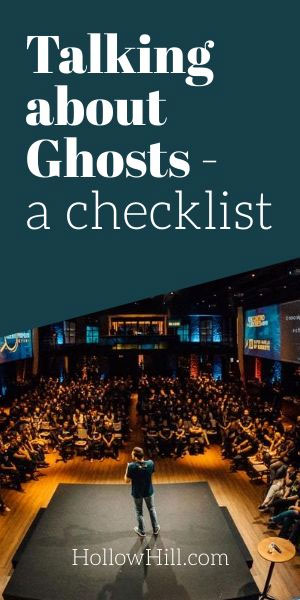As an Amazon Associate I earn from qualifying purchases. Click for details.
For many years, I’ve spoken to groups of all ages, kinds and sizes. It’s a delight to tell people about this field.
I’ve learned a lot about what to say (and what not to say) and when to say it.
I hope this checklist helps you when you’re asked to speak in public, too.
Remember: You don’t have to include everything from this list. It’s a guideline to make presentations easier.
CHECKLIST
 1. Introduction
1. Introduction
- Your name (or the name you use for this work) and where you are from.
- How long you have been involved in paranormal research.
- Why you began this research.
- If you have a specialty, what it is, and why it is important to this research.
2. About your team (if you are part of one)
- Name of your team, where it is based, and the area you cover.
- How long your team has been researching.
- Introduce team members by name and specialties, if they are with you.
- What services you provide to the public (investigations, training, talks like this one) and how much — if anything — you charge.
3. The tools you use (if any)
- Hold up each tool and explain what it is called, what it does, and how often you use it in your work.
- Describe what you have brought with you to demonstrate (such as how an EMF meter works) or what you will be presenting (audio, video, a walking tour, etc.).
- Explain which tools can be used by anyone (hiking compass/EMF meter, flashlight for yes/no, etc.) and which are best for professionals (IR video cameras, Frank’s Box, and so on.)
4. Present your information
- If you are reporting on one or more investigations:
- Give an overview first.
- Explain where you researched, when, and why.
- Describe your experiences floor-by-floor and room-by-room. (A floor plan or map may help them visualize each encounter.)
- Tell the audience what “normal” would be, before each recording or demonstration.
- Demonstrate the research technique or play the recording three times (if it is short) and then ask if anyone has a question about that evidence.
- Take general questions and discuss specific situations at the end of the talk.
- If you are telling “ghost stories,” tell people whether they are fictional or your true experiences.
- Illustrate your stories with photos, recordings and/or drawings.
- Remember that your audience wants to be entertained. Use broad gestures, lots of variety in your voice, and so on.
- If you are taking the group on a walking tour, talk about where you are going, safety concerns, and your general rules (such as when they can ask questions). Then, lead the tour. (Optional: Organize them in teams of two, so no one gets lost or left behind.)
5. Close the talk
- Tell them that you have completed your presentation.
- Ask for questions or comments. Be sure they understand that there are no firm answers to most questions, and that is why we are still conducting research.
- Refer the audience to your website, books, events, workshops, etc., for more information.
- Close with contact information, and distribute any handouts you brought with you.
- Explain that you have to leave at a certain time (be specific and stick to that), but you are happy to talk with people privately — for just a few moments — if they have questions.
- Thank them for attending.
- Smile when they applaud.
- Before leaving, thank your host and give them a small gift (e.g., a book, a CD of EVP or a general presentation, a “ghost photo” from the location).
[Thanks to Claudia of Parahunt.com for restoring this.]
